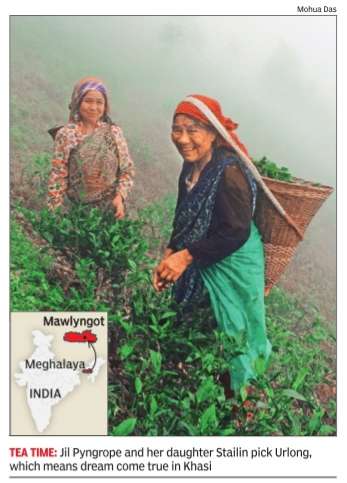Mawlyngot
This is a collection of articles archived for the excellence of their content. |
A hub of emerging tea business
Mohua Das, These hooch brewers turn new leaf with organic tea, Aug 21 2017:The Times of India

Mawlyngot in Meghalaya's East Khasi Hills has switched from brewing arrack to growing tea
Peals of laughter pierce the silence of the Kha si and Jaintia hills but it isn't easy to pinpoint the source through the swirling mist. A short distance ahead are mother and daughter Jil Pyngrope, 75, and Stailin, 40, standing on an incline plucking tea leaves, tossing them into baskets on their backs. Their chuckles hide the gloom of a difficult past. For the inhabitants of Mawlyngot village in Meghalaya's East Khasi Hills, tea is not just another crop but a means for survival and reclaiming pride. Jil and Stailin were part of an alcohol brewing community, until they found a way to better their lot by brewing delicate flavours of their own brand of tea, Urlong, which means `dream come true' in Khasi. The tea is now looking to rival the country's popular infusions from Assam and Darjeeling.
About 40km from Shillong, at an altitude of 4,800ft, the sleepy hamlet of Mawlyngot is about a century and a half old. Locals say people from the India-Bangladesh border migrated down the river Umsong and settled on the hills. Early inhabitants thrived on smallscale cultivation of yam, corn, millet, potato, chilli and banana but with lower yields and absence of policing, they turned to the easy-to-brew country liquor `pyrsi' made from rice and millet.
Mawlyngot's brewery soon became reason for the community's steady collapse -broken homes, chronic illnesses, drunken brawls and penury .“As a landless villager with no education, brewing pyrsi was an easy way to earn money . You can't escape addiction when you're brewing alcohol all day . I would often get into fights on the streets,“ says Phroshon Songthiang, 39. Phroshan is now a changed man who manages the community-run tea processing unit.
The turnaround began after village headman D L Nongspung stumbled upon camellia shrubs a plant from the tea family growing in the area. The soil enriched by the rare presence of blue worms made the place ideal for tea cultivation.
For Nongspung, it was “a command from God“ to wean away Mawlyngot from the spirit. “What struck me after moving here in 1987 was the number of children dropping out of school. The rate was 60%, and the main reason was families being unable to afford books or fees as they earned less than Rs 1,000 a month from brewing illicit liquor,“ he recalls.
With an initial funding of Rs 58 lakh from the tribal af fairs ministry and a community contribution of Rs 5 lakh in 2003 and NGO World Vision's intervention, 25 farmers in the village started learning the art of harvesting tea.
It wasn't until 2007 that the first batch of tea leaves was plucked. “The farmers were eager to switch to a new way of life but the start wasn't easy,“ says Nongspung. Land holding being small and fragmented, farmers would sell their produce locally for a small profit. So they got together to form the Urlong Tea Integrated Village Cooperative Society in 2011, a society that currently comprises 41 farmers who own individual gardens with an implied agreement of interdependence. “They sell the leaves plucked from their gardens to the society-owned tea processing plant for the collective benefit of all farmers,“ explains Nongspung.Besides a daily wage for plucking of Rs 300 for males and Rs 200 for females, land owners get up to 15% share in the annual profit.
From an annual sale of Rs 2 lakh for 300kg a decade ago, the turnover has increased to Rs 15 lakh for 3,000kg of green, black and white tea in 2016.
Ivashisha Pyngrope, secretary of the tea growers' society, has returned to Mawlyngot after finishing college in Shillong. “I want to do my bit for my village too,“ says the 31-year-old. “I've seen my house filled with jerry cans of liquor, my father drink uncontrollably and the family turn asocial,“ she says, but her eyes light up when she recalls the first coat of paint and an almirah her house got after her father switched to tea gardening. “He is sober now, spends quality time with us, eating meals at home, praying at church and discussing the farm,“ she says.
Markers of civic progress -schools, electricity, footpaths, a guesthouse and motorable roads have begun to appear in the village. Seven neighbouring villages are also replicating Mawlyngot's model. Currently a popular item on the racks in Meghalaya, Kolkata, Bengaluru and Delhi, the first flush of Oolong tea has also found takers in Australia. Mawlyngot's cultivation practices are organic and they received certification from the Control Union, which helps Urlong tap the international market.
“Mawlyngot is now on the tourist map,“ says Nongspung. “We're hoping for more people to come find us.“